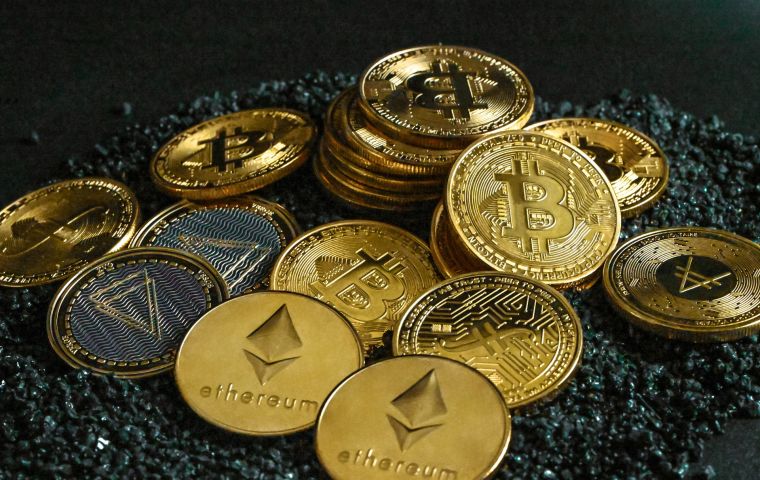MercoPress. South Atlantic News Agency
Latin America’s Crypto Surge: 63% Growth Reshaping Money and Markets
 Photo: Unsplash
Photo: Unsplash Cryptocurrencies are no longer a niche in Latin America’s economy; they’ve become part of everyday transactions for millions. In 2025, adoption across the region climbed 63%, putting Latin America second only to Asia-Pacific in growth. That rise has pushed the issue onto the desks of governments, regulators, and businesses looking to keep pace. For people across the region, crypto isn’t a passing trend. It’s much bigger than that; it is instead seen as a way to hold value when local currencies lose ground, to send money home without the steep remittance fees, and to step into a digital economy that often feels more reliable than traditional banking.
A Region Embracing Digital Assets
Latin America’s sharp increase in digital currency use is reshaping how money moves across borders and within local markets. Chainalysis’s Global Crypto Adoption Index ranked several countries in the region among the most active users of blockchain technology. While Asia-Pacific maintained a slightly higher growth rate of 69%, Latin America’s 63% rise is a strong sign of how quickly the technology is embedding itself in daily life.
The drivers of this adoption are clear. Citizens in countries with volatile or inflation-hit currencies see crypto as a safer place to store value. Unlike holding savings in a rapidly devaluing peso or bolívar, keeping money in Bitcoin or stablecoins offers some protection. Another factor is remittances, with millions relying on money sent home by relatives abroad, and crypto offers faster transfers at lower fees compared to traditional services. Beyond everyday transactions, people are also using digital assets for e-commerce and even luxury purchases, showing how crypto is moving into mainstream consumer life.
You can also see the shift clearly in entertainment. Crypto casinos, like Coin Casino, are gaining popularity because they mix fast payouts through multiple crypto coins with a huge variety of games, plus exciting bonuses like welcome offers, cashback, and free spins. These platforms show how digital assets are moving past finance and into everyday leisure. The same is true for shopping and luxury purchases, where crypto is becoming part of normal consumer life across the region.
El Salvador’s Changing Relationship with Bitcoin
El Salvador became the first country to make Bitcoin legal tender back in 2021, a move that drew global headlines. Four years later, in 2025, the government adjusted its approach. Businesses are no longer required to accept Bitcoin; they can choose whether to accept it or not. The state still maintains its Bitcoin reserves, which continue to show unrealised profits, but the mandatory framework proved unpopular and complicated when the country sought international loans.
Despite this policy change, El Salvador hasn’t abandoned its Bitcoin experiment. What’s changed is the way it’s applied, less pressure on businesses, more room for choice. The adjustment recognises that not everyone was ready to pay or get paid in crypto, but it also underlines that Bitcoin is still woven into the country’s economic path forward.
Brazil Leading on Regulation and Innovation
Brazil has become the most hands-on country in Latin America when it comes to regulating crypto. Back in 2023, lawmakers introduced Law 14,478/22, which forced exchanges and other providers to operate with licenses, follow anti-money-laundering rules, and put consumer protections in place. It was one of the first serious attempts in the region to move crypto out of the grey zone and into a system people could actually trust.
But regulation isn’t the whole story. Brazil’s central bank is testing Drex, a digital version of the real that’s meant to make everyday payments faster and give more people access to the financial system. It’s still in the pilot stage, with a broader rollout expected later. On top of that, the government introduced a 17.5% tax on crypto gains in 2025. The move made profit reporting clearer but also took away the small exemptions that casual investors once had. Brazil is opening the door to digital money, while making sure the rules are strict enough to keep everything stable.
Panama’s Push Toward Crypto Recognition
Panama wants to be seen as a fintech hub. In early 2025, lawmakers proposed a bill that would let people pay with Bitcoin, Ethereum, or stablecoins if both sides are on board. It also added rules for crypto companies, making sure they get licensed and follow checks against money laundering.
The bill also looks at how blockchain could be used in everyday government work. There’s talk of a digital ID and bringing more public services onto blockchain systems. Nothing’s final yet, since the bill is still being debated, but the goal is clear. Panama is chasing crypto companies and the investment that comes with them.
Guatemala’s Gradual Steps Toward Regulation
Guatemala is moving carefully but steadily when it comes to crypto. In May 2025, lawmakers introduced a bill that would let people use digital currencies if they want, while the quetzal would stay as the official money. It’s a slower, more cautious approach than El Salvador’s full-scale Bitcoin rollout. The proposal includes tax breaks for small payments and asks crypto service providers to register with the banking regulator.
Even without new laws in place, crypto is already finding its place in everyday life, especially through remittances. Banco Industrial’s Zigi app, which runs on the SukuPay stablecoin, lets families receive money from the U.S. almost instantly and at much lower cost than traditional methods. Since remittances are such a big part of Guatemala’s economy, these savings and speed matter a lot. If the bill becomes law, it would give these services a stronger legal foundation and more protection for users.
Regional Cooperation and the Road Ahead
Crypto is moving fast in Latin America, and countries are beginning to team up. In 2025, El Salvador and Paraguay made a deal to share knowledge and work together on oversight, showing that real progress depends on cross-border cooperation.
Adoption in the region jumped 63% that year, proof that this isn’t just about speculation. It’s changing how people manage money, protect savings, and make payments. From El Salvador’s experiments to Brazil’s strict rules and Panama’s fintech push, Latin America is finding its own way and starting to influence the global direction of digital assets.




Top Comments
Disclaimer & comment rulesCommenting for this story is now closed.
If you have a Facebook account, become a fan and comment on our Facebook Page!